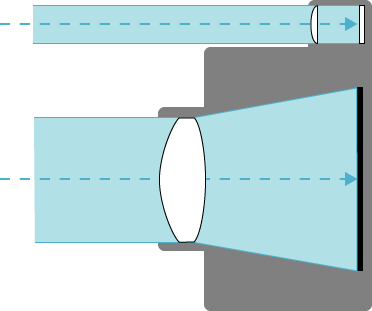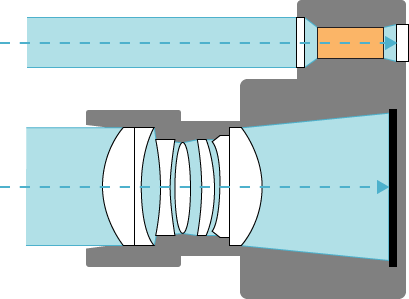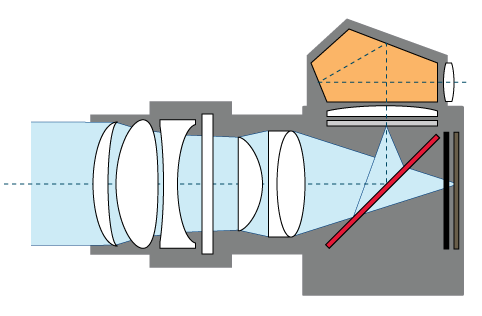Camera Types
A camera type refers to the functioning, rather than the format (or film size). Most types can be found in multiple formats formats. How a camera operates dictates what one can do with that camera, as each type has advantages and disadvantages. Rather than an exhaustive compendium of the different types, this section will generally look at those advantages and disadvantages. It should be noted, that in general, the larger the format, the higher the cost.
Point-and-Shoot

A point-and-shoot camera, as the name implies, is the simplest to use. They are generally inexpensive, consumer (as opposed to professional) grade, and are capable of taking reasonable, consumer-grade photographs. The point-and-shoot camera was was created to bring photography into mainstream usage. The Brownie (patent drawing on next page) was patented in the late 19th century by George Eastman. The invention of roll film made theses cameras possible.
The Brownie was produced by Kodak and its subsidiaries for some 65 years. Later versions of the Brownie became more sophisticated, adding such amenities as a viewfinder. The Brownie, of course, was not the only point-and-shoot. The idea of a camera that was extremely simple to operate has persisted to this day. What these cameras have in common is their ease of use. There is little user interaction, short of pushing the shutter release. The lenses are fixed-focus, which will give a reasonable focus within a normal distance. There is usually no ASA, or film speed setting to change. Load the film, and snap away.
Point-and-shoots have a wide range of sophistication, from very simple to fairly complex, while remaining simple to operate. They may have built-in strobes (flashes), zoom lenses of fairly high quality, red-eye reduction, auto-wind and rewind. At the other end of the spectrum, they may have rather crude plastic lenses and rudimentary viewfinders. They may be single-use, or ‘disposable’.
These cameras are still popular. An entire genre a photography is based on the use of ‘plastic’ cameras. These are Holgas, Dianas, Blackbirds, and more, cheaply produced, and valued for the defects inherent in the lack of precision. These cameras leak light, have crude plastic lenses, and are generally the opposite of precision. Photographs taken with these cameras often have a enigmatic quality caused by the ‘defects’.
Another type of point-and-shoot is the pinhole camera. These cameras are pared down to essentials: a light-tight box with a hole in it. They use a very tiny aperture, a pinhole (often literally made by a pin), rather than a lens. They may use film, or even photographic paper the capture an image. They usually use large format film, but can be built to use a variety, of formats. The very small aperture yields an extremely long depth of field, but requires long exposures.
Rangefinder

The rangefinder camera utilizes an optical device called, well, a rangefinder as a viewfinder and focusing aid. Essentially two prisms, one set and the other movable, the the movable prism is moved until the image resolves. Most rangefinders are coupled, with the movable part geared to the lens. The rangefinder is usually 35mm or 110/220 format, using roll film. It was first introduced around 1930, by both Leica and Zeiss Contax.
The rangefinder, most popular in 35mm, has many of the same benefits as the twin lens reflex. It has fewer moving parts, which means less noise and vibration, and less maintenance. It also shares the disadvantages, such as the parallax error between the viewfinder and lens. Although rangefinders can have interchangeable lenses, the use of zoom lenses is pretty much non-existent (there are only one or two rangefinders with zoom-capable viewfinders).
This type of camera (and Leica) has survived into the digital realm. Akin to the rangefinder, also digital, are the mirrorless system cameras, such as the Canon Eos M, the Fujifilm X-Pro 1, and the Nikon 1 Series.
Twin Lens Reflex

The twin lens reflex (TLR) uses two lenses of the same focal length (hence ‘twin’), mounted vertically. The top lens is used for the viewfinder, viewed from above (the camera held at waist level). The bottom lens is the ‘taking’ lens, or the objective lens. These cameras date from the 1880’s, and were an improvement over previous cameras in that the focus screen, or ground glass, did not have to be swapped out for the film or plate to take an image. The are largely 110/120 format, using roll film.
There are several advantages to the TLR, including mechanical simplicity and quiet operation. Another is that when filters are being used, the viewfinder remains clear, as the filters are on the taking lens. Perhaps the biggest advantage is the larger (than 35mm) negative.
The drawbacks to the TLR are several. The most problematic is that the lenses are not interchangeable. A second is that using one lens to view and another to take causes parallax error. The two images are at slightly different angles. The image is also reversed from left to right in the viewfinder, which can take some getting used to. Most use a leaf shutter, which have a maximum speed of 1/500th second, which is slow compared to most Single Lens Reflex.
The Twin Lens Reflex is still produced, notably by Rollei.There is also a plastic version, which uses 35mm film, called the Blackbird, Fly.
Single Lens Reflex

The single lens reflex camera is probably the most popular type ever produced. Primarily a 35mm (135) format, there are medium fromt SLRs. The popularity of this type comes for many reasons. The viewfinder shows what the lens sees, orientated correctly. This is due to a pentaprism (five-sided prism) mounted in the viewfinder. The SLR is modular, which most importantly means that the same body can use many lenses, as well as many accessories. It is compact, can be handheld in most situations, and uses roll film.
The biggest disadvantage of the SLR is the negative size, at least in 35mm. It is possible to make enlargements up to 16 × 20″, using very slow film, but in most cases 11 × 14″ is the practical limit, particularly when using fast film. anything larger and grain starts to become an issue.
Field Camera

The field camera is a (somewhat) portable large format camera. It is generally designed to fold up into a compact box. The field camera has much the same movements as the view camera, but they will be somewhat limited. Both Wista and Linhof still manufacture field cameras, the former in wood, and the latter in metal.
Using a field camera requires a fair amount of gear: tripod, film holders, a light meter. The benefit of the large negative may well outweigh the disadvantages.
View Camera

The view camera provides the most control over image making. It consists of several modular parts: the rail, the front standard, which holds the lens, the rear standard, which holds both the ground glass view screen, and a bellows, connecting the front and rear standard. Both the front and rear standards can be moved independently. These movements are vertically, up and down, horizontally side-to-side, swings, or rotation on the horizontal axis, and tilts, rotation on the vertical axis. This ability allows for great control over the image, unlike other types, which maintain a parallel relationship between the lens plane and the film plane. Image control and the large format are the greatest advantages to a view camera. A 35mm negative needs to be enlarged some 900%, or 9×, to make a 6 × 9 print. A 4 × 5 inch negative only 2× (200%) to make an 8 × 10" print.
The view camera uses lenses employing leaf shutters. This means the shutter ins incorporated into the lens. One advantage to this is that it will synchronize with a strobe at any speed.
The major downside of the view camera is its bulk, and the required accessories. The view camera requires a sturdy tripod. Film is loaded into holders, a sheet at a time, so there is not the ease of use of roll film. Film is expensive, compared to smaller formats. Lenses are expensive. Using a view camera, on the whole, is a very deliberate exercise.